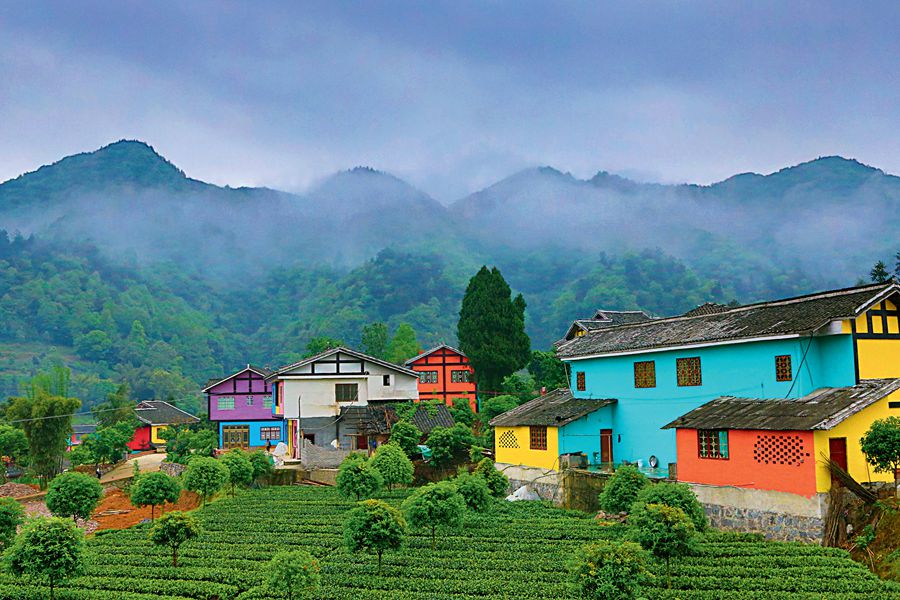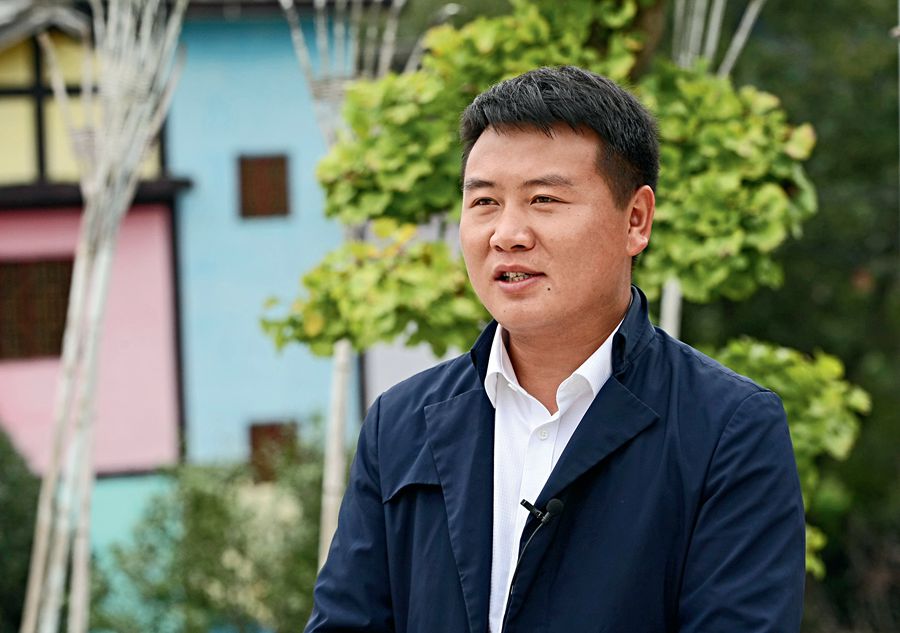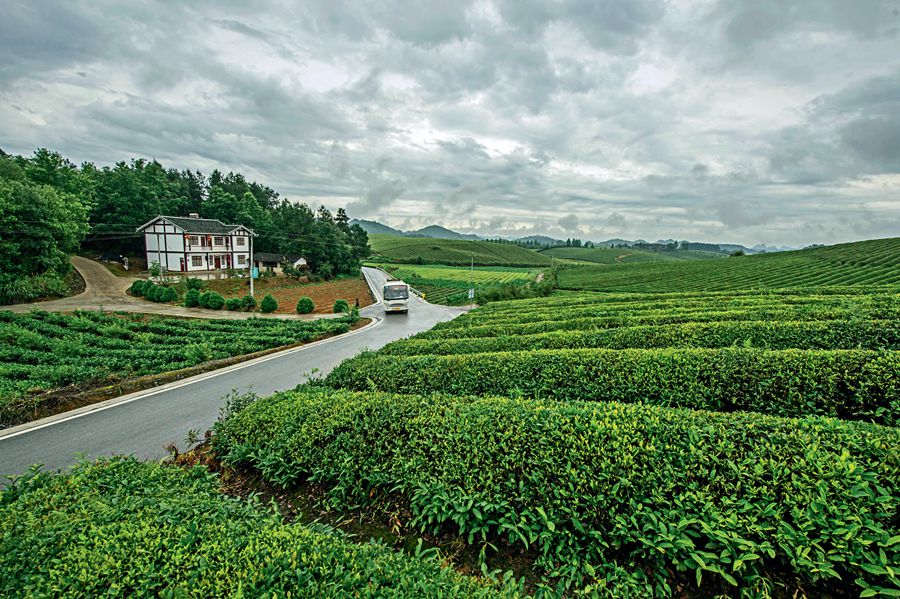THE villagers of Hetaoba in Meitan County, southwest China’s Guizhou Province, used to say that they eat maize flour mixed with rice every meal, and climb across mountains to get drinking water. Young men cannot wait to escape the distress and seek a livelihood outside, whereas girls do not want to marry people from the mountains.
However, with time has come progress. “Now I’m going to Meitan to be a farmer” has become the new buzzword among migrant workers.
Meitan, located in the north of Guizhou Plateau, was once a widely-known poor county under the state’s support. Today, the area depends on 40,000 hectares of organic tea plantations to ensure a comfortable lifestyle for farmers. Tea plantations have become the county’s golden goose.
From Farmers to “Tea Bosses”
Liu Zeyuan, a resident from Hetaoba Village, is busy in his tea processing factory. The 45-year-old man has been growing tea with his parents since he was 15. Now, he has rented out his 0.8-hectare tea plantation to others for planting and management, while he set up his own tea processing plant, which specializes in processing and exporting upmarket green and black tea. His net profit is more than RMB 600,000 (US $88,550) a year. The former tea grower has been elevated to a “tea boss.” And there are some 80 “tea bosses” like him in Hetaoba Village.

The lush landscape of Jinhua Village in Meitan County.
Behind the transformation is the vitality of local economy boosted by the tea industry.
Walking into the village, you will see tea plantations resembling green carpets scattered across the hills. Tea houses, local dwellings, forests, and tea plantations add a radiance and beauty to each other.
“It used to be a well-known poor village, where the farmers depended on growing grain for their livelihood with per capita annual income less than RMB 1,000 (US $147),” recalled Chen Tingming, the secretary of the Hetaoba village branch of the Communist Party of China (CPC). In order to address the conditions of poverty, local villagers began planting tea trees in 1983 under the leadership of He Dianlun, then secretary of the CPC village branch. Through continuous cultivation, the tea planting area of Hetaoba village has grown from 0.3 hectares to 720 hectares today.
The rapid expansion of tea plantations benefitted from the natural environment and climatic conditions in Meitan. Moreover, the National Zhejiang University, predecessor of the present Zhejiang University, moved west to Meitan in 1940 during the War of Resistance against Japan. During the seven years of its presence, the university brought the best tea leaves and processing techniques of making West Lake Longjing Tea and black tea to local people. The quality and reputation of locally-produced tea was greatly enhanced.
“Relying on the development of the tea industry, the annual net income per capita of more than 3,600 households in the village reached RMB 16,400 (US $ 2,447.6) last year,” said Chen Tingming, noting that the village now has its own processing plant and tea brand. As a result, every family has their own car, and more than 80 percent of farmers live in modern accommodation. Nowadays, Hetaoba Village has built up a complete industrial chain integrating tea plantation management, seedling cultivation, tea processing, and marketing.
The thriving tea industry has attracted a large number of migrant workers. At present, the village has more than 3,000 migrant workers, who have all escaped from the clutches of poverty and achieved prosperity through working at the tea plantation.

Feng Yanqing, secretary of the Party branch in Jinhua Village. Yu Jie
Hetaoba Village is only a microcosm of the development of the tea industry in Meitan County, which has become the pillar industry of the local rural economy. Meitan is now known as the “first county of tea in Guizhou Province,” and tea products like Meitan Green Sprout and Zunyi Red have been sold at home and abroad. In 2017, there were more than 500 tea enterprises in Meitan County, with a total output of 616,000 tons valued at RMB 4.271 billion (US $640 million) and the comprehensive income topping RMB 10 billion(US $1.4 billion).
Integration of Tea Planting and Tourism
The development of the Meitan tea industry has also spurred local tourism and the integration of tea planting and tourism. Visitors to the Hetaoba Scenic Spot alone last year hit 70,000. In Meitan, such rural tourist spots are located in more than 10 towns throughout the county. In addition to the Hetaoba Scenic Spot, the Seven Colorful Tribes scenic area is another example of integration of tea planting and tourism as an approach to poverty alleviation.
The predecessor of the Seven Colorful Tribes is the Daqinggou formation in Jinhua Village, Meijiang Town, where people lived in extreme poverty. Since 2015, Jinhua Village has adopted a new development mode of integrating tea growing and tourism. The villagers painted the exterior walls of their houses in various colors, and started rural homestays and tea houses. “Nowadays, every household in Jinhua Village has benefitted from tourism, and more than half of the villagers have bought houses in the downtown area. In addition, almost every family has a car,” said Feng Yanqing, secretary of the CPC Jinhua village branch.
Rao Xifeng, a 27-year-old local villager, used to work as a migrant worker in Shanghai, Jiangsu Province and other places for many years. After witnessing the development and changes at home, he decided to return to his hometown and get involved in the tourism business. “Many young people in Jinhua Village chose to go to the cities looking for work, leaving only the elderly and children at home; but now, they have returned home,” said Feng Yanqing.
Rao also brought his girlfriend back home to help him run his business. “We remodeled our house into 10 rooms. I opened a rural inn, and she ran a bubble tea bar. Our tea plantation is also in a tourism cooperative,” said Rao, noting that they were satisfied with their current life as their gross income exceeds RMB 200,000 (US $29,516) a year.

A Meitan tea plantation resembles a sprawling green carpet.
“Before, we rural people would migrate into the cities to work, while now urban people are coming to work in the countryside,” said Feng. During the tea-picking season, an average of 2,000 urban residents come from the county downtown to Jinhua Village by bus every day. They can earn about RMB150 (US $22) to RMB 200 (US $30) a day by picking tea. Moreover, more than 1,000 households in some poor villages in neighboring counties also moved to Jinhua Village to specialize in tea cultivation and production.
Over the past three years, tourism has become the pillar industry in Jinhua Village, with tea revenue accounting for one third of the collective annual income, which has increased from RMB 200,000 (US $29,516) to RMB 2.6 million (US $390,000 million). The net income per capita of more than 2,500 villagers exceeds RMB 30,000 annually (US $4,427).
Seven Colorful Tribes in Jinhua Village is only one example of the integration and development of tea planting and tourism in Meitan. In 2017, the county received more than 5 million tourists, bringing in a total income of RMB 2.95 billion (US $445 million), and lifting more than 1,000 poor people out of poverty directly.
Expanding the Market
Along with the effective integration of tea planting and tourism in Meitan, marketing local tea is also carried out professionally.
There are 35 green tea markets in Meitan, where fresh green tea leaves can be traded in 30 minutes. Liu Qinglian, 50, of Liuhedu Village, sells fresh tea leaves every day at the tea market in Jinhua Village. “We can earn more than RMB 200 (US $30) by selling 20 kilograms a day. After selling the green tea leaves, we go directly to the nearby markets to buy vegetables before going home,” she said.
Liu, who has been growing tea for 30 years, wasn’t always so confident about the prospects of the tea industry.. “When we first planted tea, we could only earn RMB 10,000 (US $1,476) per 10 mu (0.67 hectares) a year due to the poor sales, so it was hard to make a living,” she recalled. Now, relying on the Shenqing trading market in Meitan tea region, she can easily sell tea out every day, and earn RMB 100,000 (US $14,758) per 10 mu (0.67 hectares) a year.
In recent years, customizing tea products have been a trending business. “In the past, we would find markets after the tea production, while now production is based on customer requirements; in the past, tea was sold by weight, now it is sold by growth area.” Zhao Jiwei, general manager of Meitan Qinyuanchun Tea Co., Ltd., explained that now customers only need to pay RMB 800 (US $118) per mu (0.07 hectares) of tea plantation for annual fee and RMB 365 (US $53.9) for management fee to place it under the unified management of the company. In tea-picking season, they pay a certain processing fee, and then all the tea grown in the plantation can be harvested.
At present, Qinyuanchun Tea Plantation focuses on such tailor-made tea products and services. “Last year, the plantation leased out more than 70 hectares of its planting area, while more than 28 hectares have been booked at the start of this year,” said Zhao. The mode of tea production has become increasingly popular in Meitan.
In addition, the county is also harnessing the online marketplaces like Taobao, Tmall, and JD.com to promote tea sales. So far, more than 300 tea-selling stores have been opened on these platforms, handling a trading volume of more than RMB 100 million (US $15 million).


